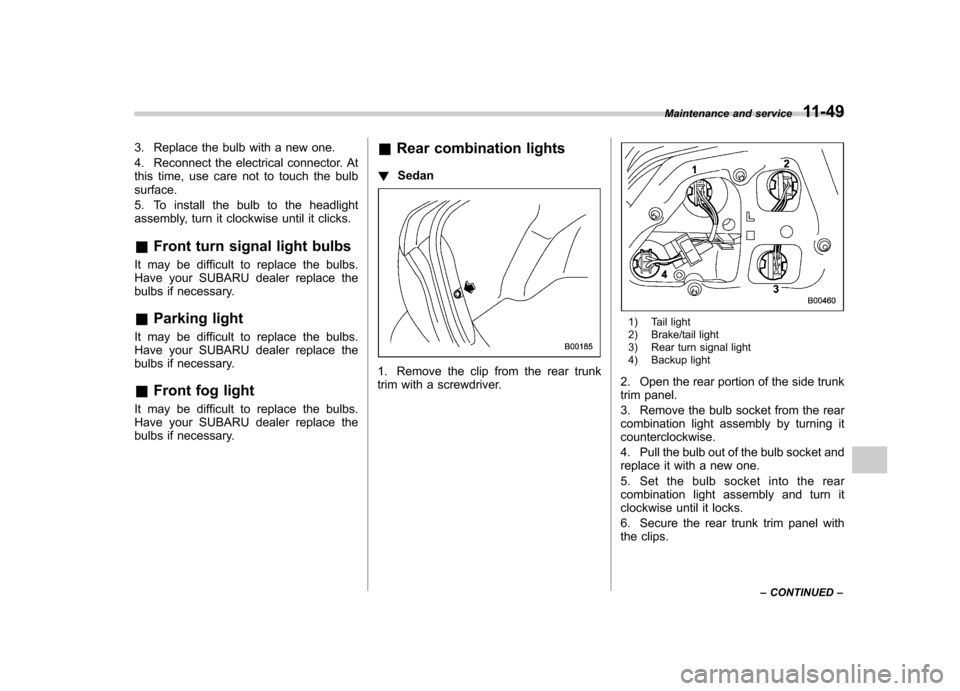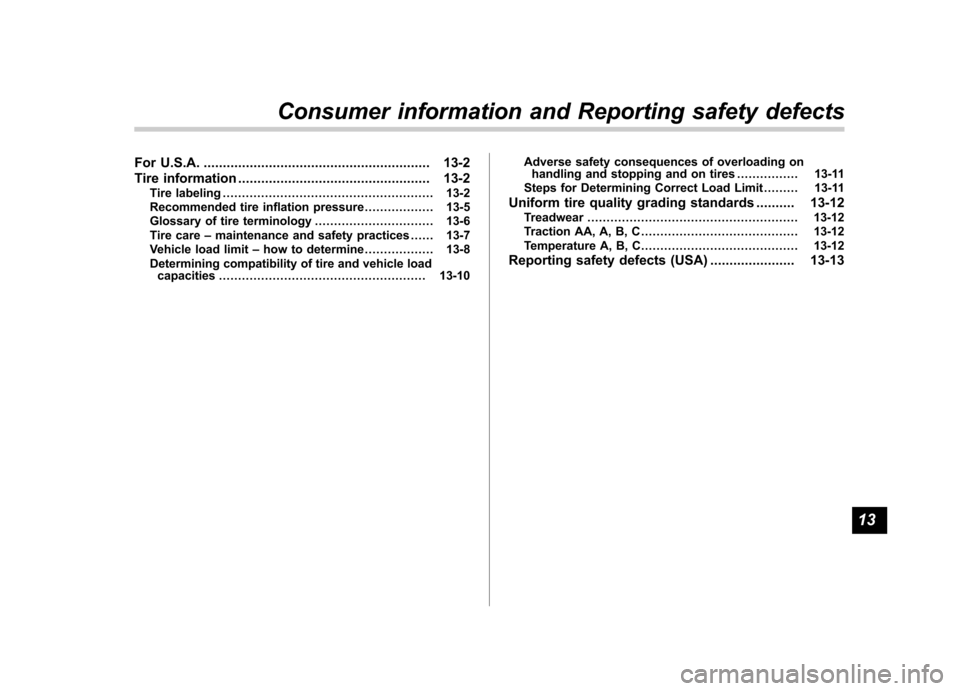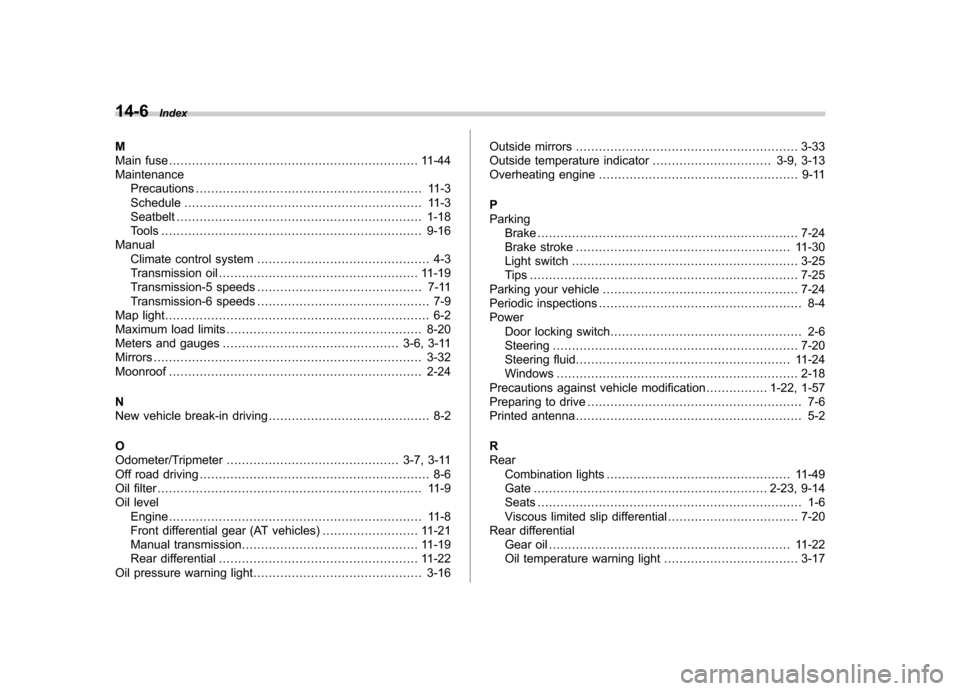Page 325 of 364

3. Replace the bulb with a new one.
4. Reconnect the electrical connector. At
this time, use care not to touch the bulbsurface.
5. To install the bulb to the headlight
assembly, turn it clockwise until it clicks. &Front turn signal light bulbs
It may be difficult to replace the bulbs.
Have your SUBARU dealer replace the
bulbs if necessary. & Parking light
It may be difficult to replace the bulbs.
Have your SUBARU dealer replace the
bulbs if necessary. & Front fog light
It may be difficult to replace the bulbs.
Have your SUBARU dealer replace the
bulbs if necessary. &
Rear combination lights
! Sedan
1. Remove the clip from the rear trunk
trim with a screwdriver.
1) Tail light
2) Brake/tail light
3) Rear turn signal light
4) Backup light
2. Open the rear portion of the side trunk
trim panel.
3. Remove the bulb socket from the rear
combination light assembly by turning itcounterclockwise.
4. Pull the bulb out of the bulb socket and
replace it with a new one.
5. Set the bulb socket into the rear
combination light assembly and turn it
clockwise until it locks.
6. Secure the rear trunk trim panel with
the clips. Maintenance and service
11-49
– CONTINUED –
Page 326 of 364
11-50Maintenance and service
! Wagon
1. Using a Phillips screwdriver, remove
the upper and lower clips that secure the
side cover of the rear combination light
assembly.
2. Remove the side cover.
3. Remove the upper and lower bolts.
Then, slide the rear combination lamp
assembly to the rear and remove it from
the vehicle.1) Brake/tail light
2) Rear turn signal light
3) Backup light
4. Remove the bulb socket from the rear
combination light assembly by turning itcounterclockwise.
5. Pull the bulb out of the bulb socket and
replace it with a new one.
6. Set the bulb socket into the rear
combination light assembly and turn it
clockwise until it locks.
Page 327 of 364
7. Put the rear combination light assem-
bly into place while aligning the clip with
the guide on the vehicle and fasten thebolts.
8. Install the side cover and secure it with
the clips.&
License plate light
1. Remove the mounting screws using a
Phillips screwdriver.
2. Remove the lens.
3. Pull the bulb out of the socket. Install a
new bulb.
4. Reinstall the lens.
5. Tighten the mounting screws. &
Dome light, map light and
cargo area light
Maintenance and service 11-51
– CONTINUED –
Page 328 of 364
11-52Maintenance and service
1. Remove the lens by prying the edge of
the lens with a flat-head screwdriver.
2. Pull the bulb out of the socket. Install a
new bulb.
3. Reinstall the lens. &
Trunk light
1. Remove the cover by squeezing its
sides and pulling it.
2. Pull the bulb out of the socket. Install a
new bulb.
3. Reinstall the cover. &
High mount stop light
! Sedan
1. Remove the high mount stop light
cover by prying the edge with a screw-
driver.
2. Remove the bulb socket from the high
mount stop light assembly by turning itcounterclockwise.
3. Pull the bulb out of the socket. Install a
new bulb.
4. Reinstall the cover.
Page 329 of 364
!Wagon
1. Remove the mounting screws using a
Phillips screwdriver and then remove the
high mount stop light cover.
2. Remove the bulbs from the socket by
pulling them up. Install a new bulb.
3. Reinstall the cover.
4. Tighten the mounting screws. &Other bulbs
Other bulbs may be difficult to replace.
Have your SUBARU dealer replace
these bulbs if necessary. Maintenance and service
11-53
Page 341 of 364

For U.S.A............................................................ 13-2
Tire information .................................................. 13-2
Tire labeling ....................................................... 13-2
Recommended tire inflation pressure .................. 13-5
Glossary of tire terminology ............................... 13-6
Tire care –maintenance and safety practices ...... 13-7
Vehicle load limit –how to determine .................. 13-8
Determining compatibility of tire and vehicle load capacities ...................................................... 13-10 Adverse safety consequences of overloading on
handling and stopping and on tires ................ 13-11
Steps for Determining Correct Load Limit ......... 13-11
Uniform tire quality grading standards .......... 13-12
Treadwear ....................................................... 13-12
Traction AA, A, B, C ......................................... 13-12
Temperature A, B, C ......................................... 13-12
Reporting safety defects (USA) ...................... 13-13
Consumer information and Reporting safety defects
13
Page 347 of 364

an asymmetrical tire that has a
particular side that must always
face outward when mounting on a
vehicle.
. Accessory weight
The combined weight (in excess of
those standard items which may be
replaced) of floor mats, leather seats
and cross bars to the extent that these
items are available as factory-in-
stalled equipment (whether installed
or not). . Curb weight
The weight of a motor vehicle with
standard equipment including the
maximum capacity of fuel, oil, and
coolant and air conditioning. . Maximum loaded vehicle weight
The sum of curb weight, accessory
weight, vehicle capacity weight and
production options weight. . Normal occupant weight
150 lbs (68 kg) times the number of
occupants (3 occupants). . Occupant distribution
Distribution of occupants in a vehicle,
2 in front, 1 in rear seat. .
Production options weight
The combined weight of those in-
stalled regular production options
weighing over 5.1 lbs (2.3 kg) in
excess of those standards items
which they replace, not previously
considered in curb weight or acces-
sory weight. . Vehicle capacity weight
The total weight of cargo, luggage
and occupants that can be added to
the vehicle. . Vehicle maximum load on a tire
Load on an individual tire that is
determined by distributing to each
axle its share of the maximum loaded
vehicle weight and dividing by two. . Vehicle normal load on a tire
Load on an individual tire that is
determined by distributing to each
axle its share of the curb weight,
accessory weight, and normal occu-
pant weight and dividing by two. & Tire care –maintenance and
safety practices
. Check on a daily basis that the tires
are free from serious damage, nails,
and stones. At the same time, check the tires for abnormal wear. .
Inspect the tire tread regularly and
replace the tires before their tread
wear indicators become visible. When
a tire ’s tread wear indicator becomes
visible, the tire is worn beyond the
acceptable limit and must be replaced
immediately. With a tire in this condi-
tion, driving at even low speeds in wet
weather can cause the vehicle to
hydroplane. Possible resulting loss
of vehicle control can lead to an
accident. . To maximize the life of each tire
and ensure that the tires wear uni-
formly, it is best to rotate the tires
every 7,500 miles (12,500 km). Rotat-
ing the tires involves switching the
front and rear tires on the right-hand
side of the vehicle and similarly
switching the front and rear tires on
the left-hand side of the vehicle.
(Each tire must be kept on its original
side of the vehicle.) Replace any
damaged or unevenly worn tires at
the time of rotation. After tire rotation,
adjust the tire pressures and make
sure the wheel nuts are correctly
tightened. A tightening torque specifi-
Consumer information and Reporting safety defects
13-7
– CONTINUED –
Page 359 of 364

14-6Index
M
Main fuse ................................................................. 11-44
Maintenance
Precautions ........................................................... 11-3
Schedule .............................................................. 11-3
Seatbelt ................................................................ 1-18
Tools .................................................................... 9-16
Manual Climate control system ............................................. 4-3
Transmission oil .................................................... 11-19
Transmission-5 speeds ........................................... 7-11
Transmission-6 speeds ............................................. 7-9
Map light ..................................................................... 6-2
Maximum load limits ................................................... 8-20
Meters and gauges .............................................. 3-6, 3-11
Mirrors ...................................................................... 3-32
Moonroof .................................................................. 2-24
N
New vehicle break-in driving .......................................... 8-2
O
Odometer/Tripmeter ............................................. 3-7, 3-11
Off road driving ............................................................ 8-6
Oil filter ..................................................................... 11-9
Oil level
Engine .................................................................. 11-8
Front differential gear (AT vehicles) ......................... 11-21
Manual transmission .............................................. 11-19
Rear differential .................................................... 11-22
Oil pressure warning light ............................................ 3-16 Outside mirrors
.......................................................... 3-33
Outside temperature indicator ............................... 3-9, 3-13
Overheating engine .................................................... 9-11
P Parking Brake .................................................................... 7-24
Brake stroke ........................................................ 11-30
Light switch ........................................................... 3-25
Tips ...................................................................... 7-25
Parking your vehicle ................................................... 7-24
Periodic inspections ..................................................... 8-4
Power
Door locking switch .................................................. 2-6
Steering ................................................................ 7-20
Steering fluid ........................................................ 11-24
Windows ............................................................... 2-18
Precautions against vehicle modification ................ 1-22, 1-57
Preparing to drive ........................................................ 7-6
Printed antenna ........................................................... 5-2
R Rear Combination lights ................................................ 11-49
Gate ............................................................. 2-23, 9-14
Seats ..................................................................... 1-6
Viscous limited slip differential .................................. 7-20
Rear differential Gear oil ............................................................... 11-22
Oil temperature warning light ................................... 3-17